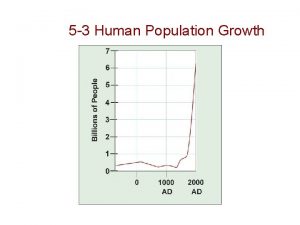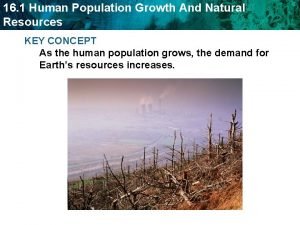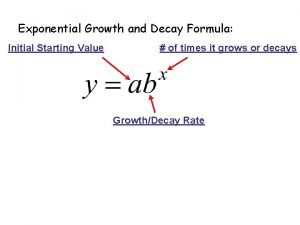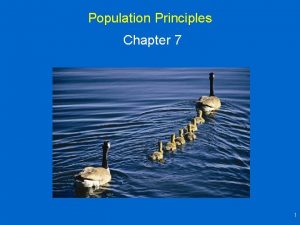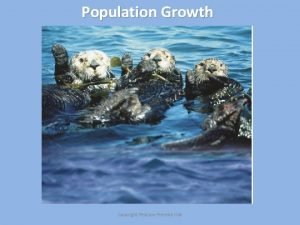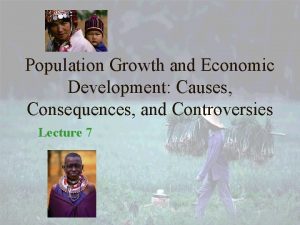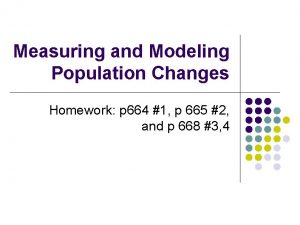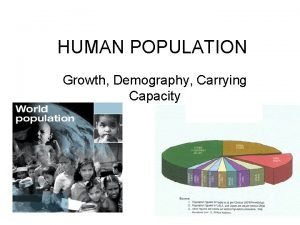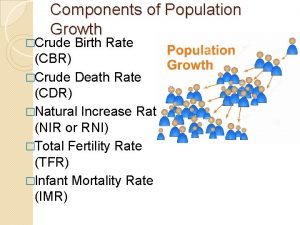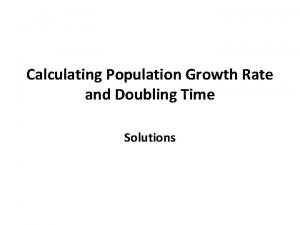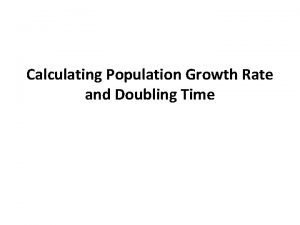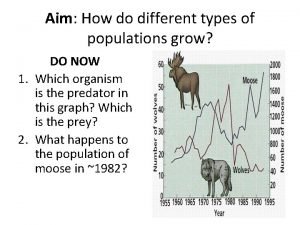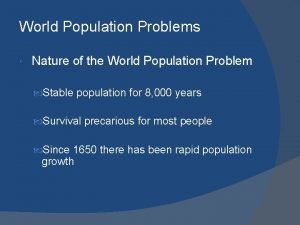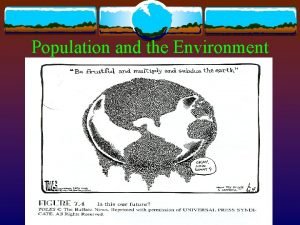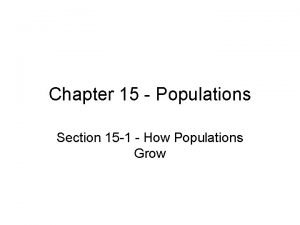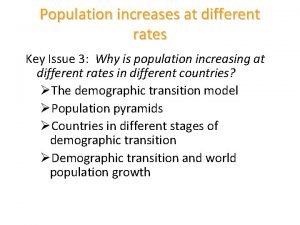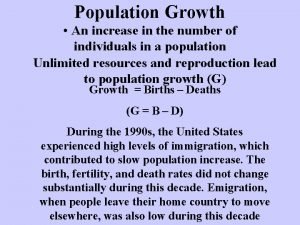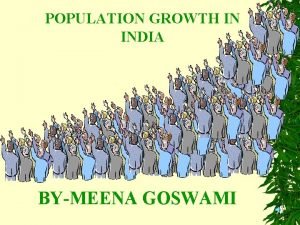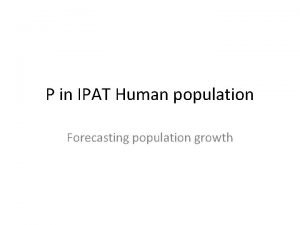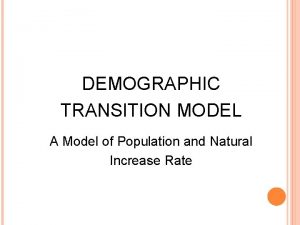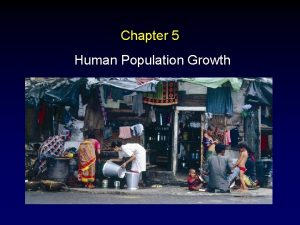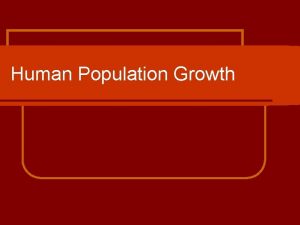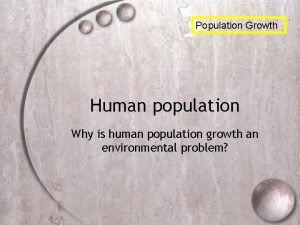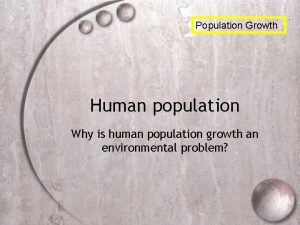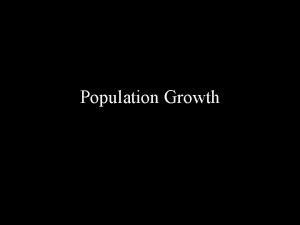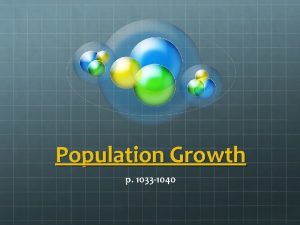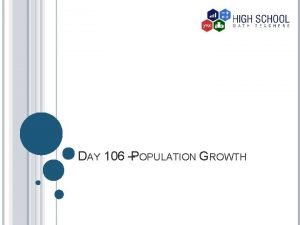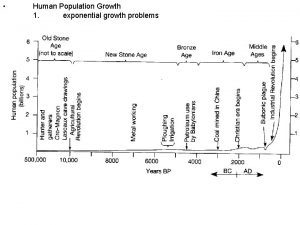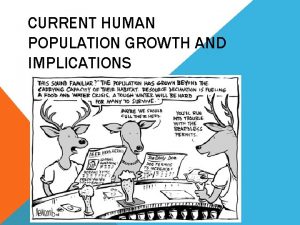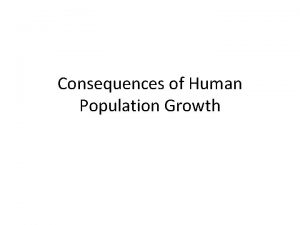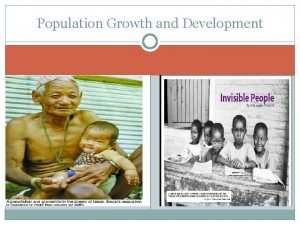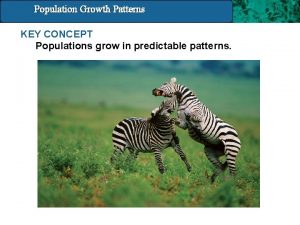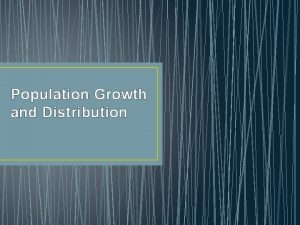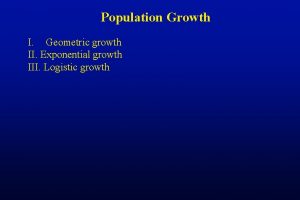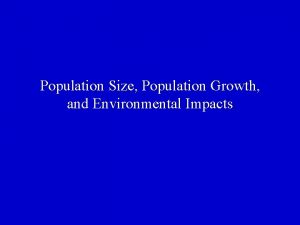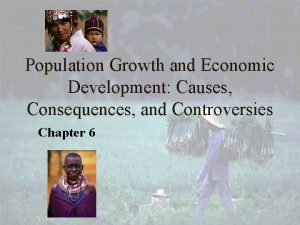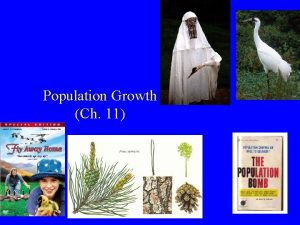Human Population Growth and the Consequences Human population



























































- Slides: 59

Human Population Growth and the Consequences • Human population expansion and its cause • Different worlds • Consequences of population growth and affluence • Dynamics of population growth

Human Population Expansion and Its Cause • Reasons for the patterns of growth – Biotic potential exceeds environmental resistance: birth rates exceed death rates • There are 7. 1 billion people on Earth • If each one stood up, pronounced their name and sat down – It would take ~800 years to complete roll call – (By 2025 it will take 1, 000 years to complete this exercise)

World Population Over the Centuries 9, 000 human beings added to the planet every hour

Reasons for the Human Population Explosion • • • Causes of disease recognized Improvements in nutrition Discovery of antibiotics Improvements in medicine Increase in number of women who actually reach child-bearing age • Short doubling times in some countries

Modeling Population Growth Human Population Growth and Regulation

Modeling Population Growth Human Population Growth and Regulation

Modeling Population Growth Human Population Growth and Regulation

Modeling Population Growth Human Population Growth and Regulation

Average Number of Children, Grandchildren, and Great Grandchildren • America • West Germany • Africa – 14 – 5 – 258

Calculating Fertility Rates and Doubling Times (CBR - CDR)/10 = Rate of Increase or decrease in population per 1000 per year 70/ Rate of Increase = Doubling Time

Modeling Population Growth Human Population Growth and Regulation

World Population Growth and Absolute Growth


Population Projections Based on Different Fertility Assumptions Gradual decline in fertility in developing countries. 2. 02 children/woman ½ child lower than medium projection ½ child higher than medium projection Maintain fertility rate of 2. 6 children/woman


Major Economic Divisions of the World Gross national income/capita

Dimensions of the Human Poverty Index


Phases of Demographic Transition • Phase I: primitive stability (CBR = CDR) • Phase II: declining CDR, CBR remains high accelerating population growth • Phase III: declining fertility rate, but significant population growth continues • Phase IV: modern stability with low CBR and CDR

Demographic Transition Comparisons (Figure 5 -17) • Phase IV: developed countries • Phases II and III: developing countries

Changing Human Survivorship Curves: Went from B to A % Survival A Birth B Age Death

Different Worlds • Rich nations, poor nations • Population growth in rich and poor nations • Different populations, different problems

Economic Categories Based on Per Capita Gross National Income (see Fig. 5 -4) • High-income, highly developed, industrialized countries – United States, Japan, Canada – Average GNI per capita = $26, 710 • Middle-income, moderately developed countries – Latin America, South Africa, China – Average GNI per capita = $1, 850

Economic Categories Based on Per Capita Gross National Income (see Fig. 5 -4) • Low-income, developing countries – Western and central Africa, India, central Asia – Average GNI per capita = $430

Disparities • Developed countries – 15% of the world’s population – Control 80% of the world’s wealth • Low-income developing countries – 37% of the world’s population – Control 3. 0% of the world’s gross national income • Difference in per capita income: 63 to 1!

Different Populations, Different Problems • IPAT Formula: calculates human pressure on the environment (I = P x A x T) – I = environmental impact – P = population – A = affluence and consumptive patterns – T = level of technology in the society

Different Populations, Different Problems • Environmental impact of developing countries due to “P. ” • Environmental impact of developed countries due to “A” and “T. ” – Both have some measure of “I” for different reasons. – Average American places at least 20 times the demand on Earth’s resources compared to a person in Bangladesh.

Different Populations, Different Problems • www. myfootprint. org – take the quiz!! • How does stewardship (S) affect the IPAT formula? – S = wildlife conservation, pollution control, energy conservation, and recycling I=Px. Ax. T S

Population Increase in Developed and Developing Countries

Population Data for Selected Countries (Table 5 -2) Country World Developing Countries Developed Countries Total Fertility Rate 2. 7 Doubling Times (Years) 58 2. 9 47 1. 6 700

Different Populations, Different Problems • Human pressure on the environment caused by three factors – Population size – Affluence – Technology

Global Conditions for a Sustainable Population • Lower fertility rates (stabilize population) – [mostly developing nations] • Consumption must decrease [affluent nations] • Protect the environment (stewardly action must increase) – [both developing and developed nations]

Developing or Developed Nations? • High fertility rates • High consumptive lifestyles: use 80% of world’s wealth • Intense poverty • Eat high on the food chain

Developing or Developed Nations? • Long doubling times • High environmental degradation • Twenty percent of the world’s population

Basic Human Needs • • • Drinkable water Edible food Safe housing Health care An education A job

The Developing Countries • Reform the system of land ownership • Intensify cultivation of existing land to increase production per unit area • Open new land to farm • Move to cities and seek employment • Engage in illicit activities for income • Move to other countries How do these “solutions” aggravate the problems?

Growing Cities

Consequences of Exploding Populations in the Developing World

Consequences of Exploding Populations MORE More Population Causes LESS deforestation resource depletion loss of agricultural land disease pest resistance biodiversity population migration Irrigation (percentage) wetlands

Affluence in the United States • Consume the largest share of 11 of 20 major commodities • Eat more than three times the global average in meat • Lead the world in paper consumption • Environment improves with increasing affluence

Affluence in the United States • Enables wealthy to clean up immediate environment by transferring waste to more distant locations • Affluent isolate themselves and unaware of the environmental stresses caused by their consumptive lifestyles

Dynamics of Population Growth • Population profiles – “age structure diagrams” show us: 1. Future populations 2. Population momentum 3. The demographic transition

Population Profile United States

Population Profile United States

(expected) Population Profile United States


Population Profile of Italy

(expected) Population Profile Italy

Population Projections United States Increased fertility rate of 2. 0 and current migration Fertility rate of 1. 8

Population Profile Developing Country

Population Profile Developing Country

Population Momentum • Effect of current age structures on future population growth – large cohorts cause large “next generations” – even if the fertility index is low. • Determined by percent of population in younger versus older age cohorts

Population Momentum • It will take countries with a large base of younger population a long time to achieve stability. • Countries like Iraq will continue to grow for 50 -60 years even after the total fertility rate is reduced to replacement level.

POPULATION AGE STRUCTURE • The number of people in young, middle, and older age groups determines how fast populations grow or decline. • The number of people younger than age 15 is the major factor determining a country’s population growth. • Changes in the distribution of a country’s age groups have long-lasting economic and social impacts.

POPULATION AGE STRUCTURE • Populations with a large proportion of its people in the preproductive ages 1 -14 have a large potential for rapid population growth. Figure 9 -9

Male Female Expanding Rapidly Guatemala Nigeria Saudi Arabia Prereproductive ages 0– 14 Male Female Expanding Slowly United States Australia Canada Reproductive ages 15– 44 Male Female Stable Spain Portugal Greece Female Male Declining Germany Bulgaria Italy Postreproductive ages 45– 85+ Fig. 9 -9, p. 179

POPULATION AGE STRUCTURE • 32% of the people in developing countries were under 15 years old in 2006 versus only 17% in developed countries. Figure 9 -10


 Population growth concept map
Population growth concept map Slow growth age structure diagram
Slow growth age structure diagram Plant growth index
Plant growth index Pith
Pith Primary growth and secondary growth in plants
Primary growth and secondary growth in plants Primary growth and secondary growth in plants
Primary growth and secondary growth in plants Natural resources and population growth
Natural resources and population growth Exponential growth function
Exponential growth function Carothers equation
Carothers equation Geometric growth population
Geometric growth population Neoclassical growth theory vs. endogenous growth theory
Neoclassical growth theory vs. endogenous growth theory Organic vs inorganic growth
Organic vs inorganic growth If a child washes his hands, he could eat with kings.
If a child washes his hands, he could eat with kings. Weigh the consequences
Weigh the consequences Choices poem
Choices poem Olavi voittonen
Olavi voittonen Hazardous attitudes
Hazardous attitudes What is the relationship between choices and consequences
What is the relationship between choices and consequences Actions and their consequences examples
Actions and their consequences examples Romeo and juliet summary act 4
Romeo and juliet summary act 4 Rising food prices causes and consequences
Rising food prices causes and consequences Actions and their consequences examples
Actions and their consequences examples Feedbackrewards
Feedbackrewards Rule of 70
Rule of 70 What are the two types of population growth
What are the two types of population growth Modeling population growth rabbits answer key
Modeling population growth rabbits answer key Survivorship curve
Survivorship curve Population growth factors
Population growth factors Why population growth is good
Why population growth is good What is population ecology
What is population ecology Logistic growth ecology definition
Logistic growth ecology definition Milton keynes population 2021
Milton keynes population 2021 Population growth types
Population growth types Why environmental science is an interdisciplinary science
Why environmental science is an interdisciplinary science Rule of 70 in population growth
Rule of 70 in population growth Population growth factors
Population growth factors Logistic differential equation
Logistic differential equation Total fertility rate
Total fertility rate Unalaska ak population pyramid
Unalaska ak population pyramid What is exponential growth in ecology
What is exponential growth in ecology Doubling time calculator
Doubling time calculator How to calculate doubling time of a population
How to calculate doubling time of a population Density-dependent limiting factors definition apes
Density-dependent limiting factors definition apes Rule of 70 in population growth
Rule of 70 in population growth What are the two types of population growth
What are the two types of population growth Importance of population growth
Importance of population growth Conclusion of population growth
Conclusion of population growth Exponential vs geometric growth
Exponential vs geometric growth Yeast population growth lab
Yeast population growth lab Exponential growth curve of a hypothetical population
Exponential growth curve of a hypothetical population Key issue 3 why does population growth vary among regions
Key issue 3 why does population growth vary among regions Population growth means
Population growth means Short essay on population growth
Short essay on population growth Percent change
Percent change Why does population growth vary among regions
Why does population growth vary among regions Chapter 4 section 1 population dynamics
Chapter 4 section 1 population dynamics Section 1 population dynamics
Section 1 population dynamics Population ecology section 1 population dynamics
Population ecology section 1 population dynamics Chapter 4 population ecology answer key
Chapter 4 population ecology answer key Stages of human growth and development pictures
Stages of human growth and development pictures

